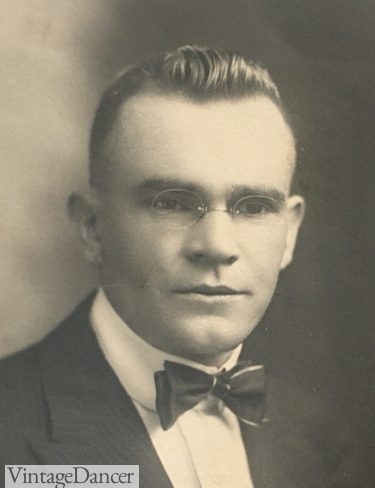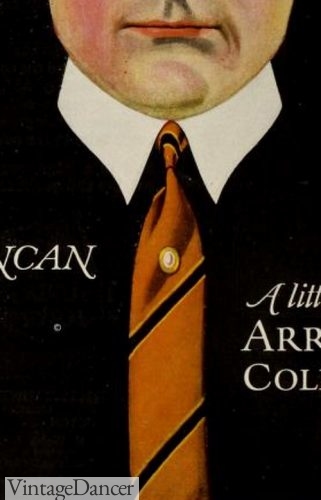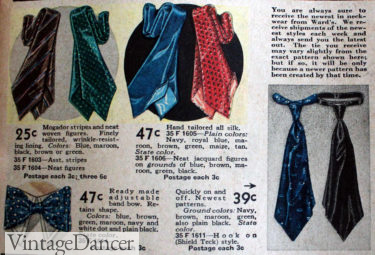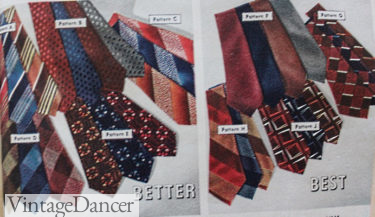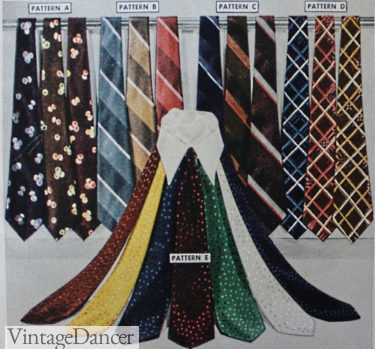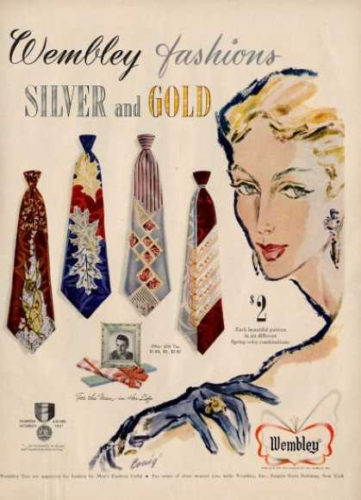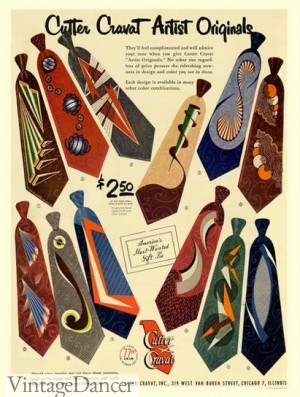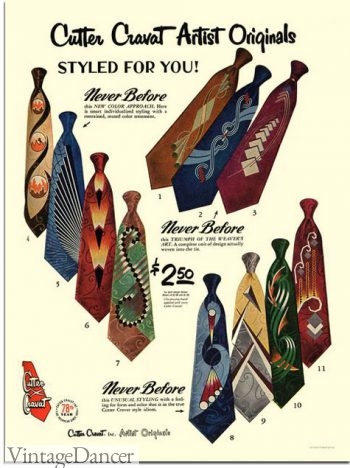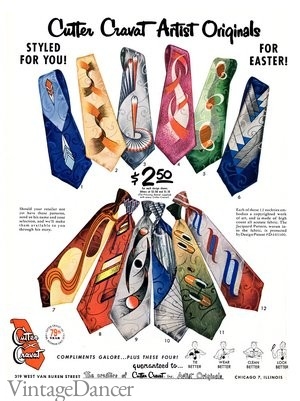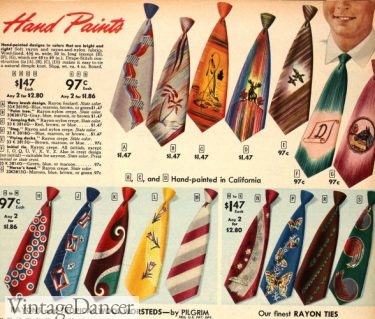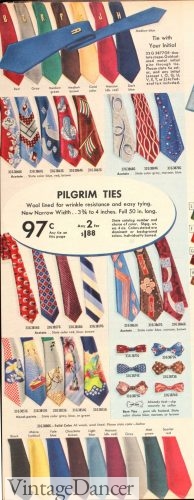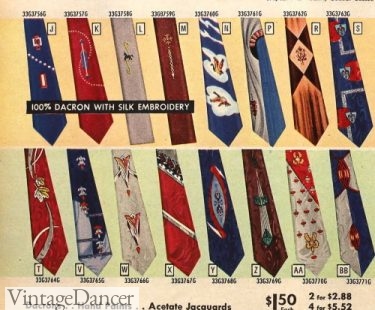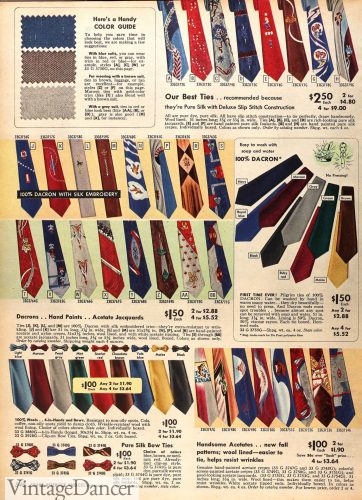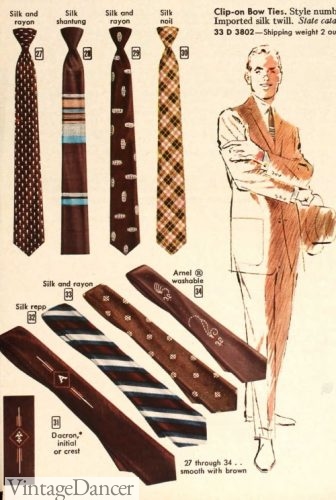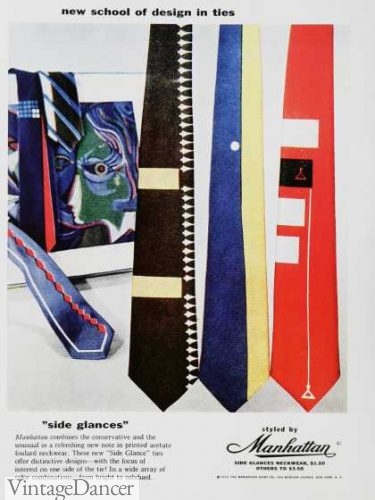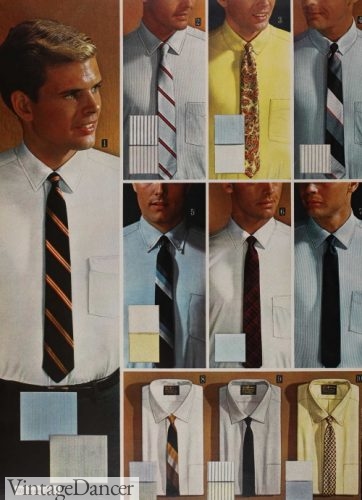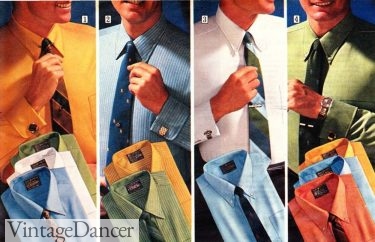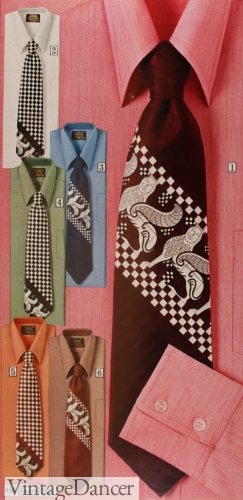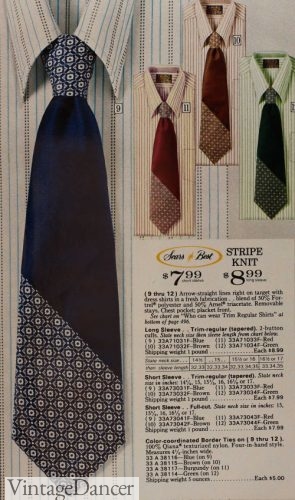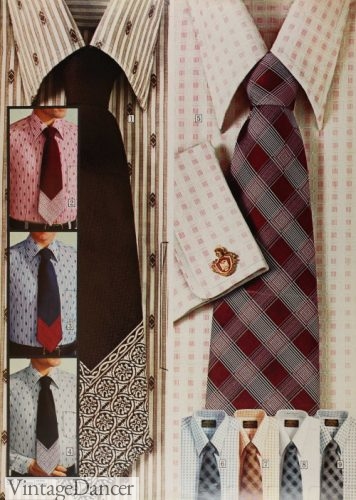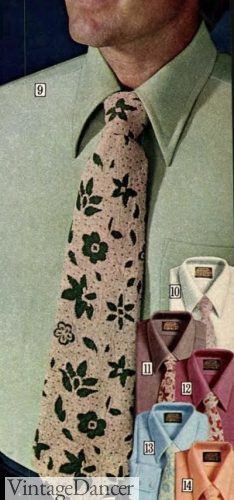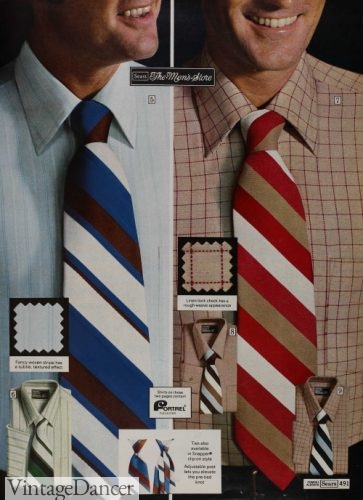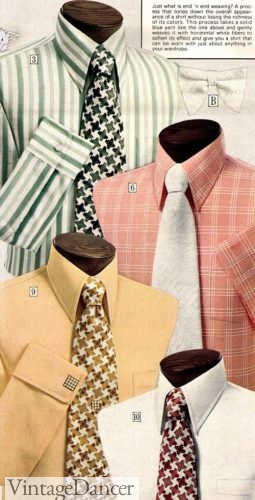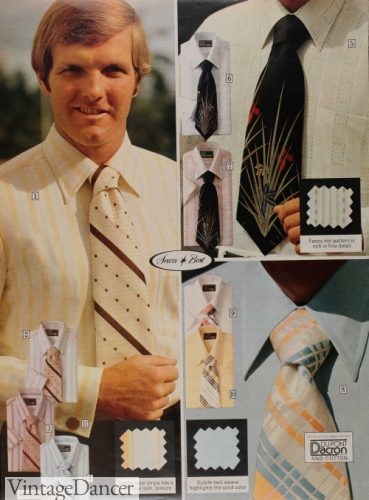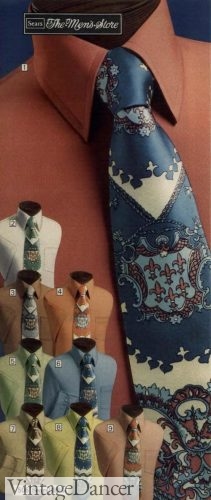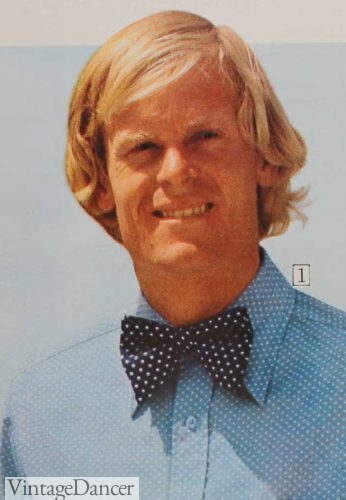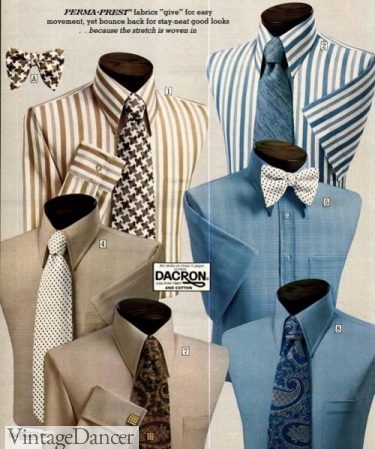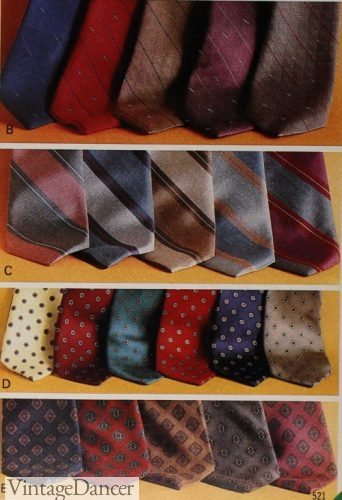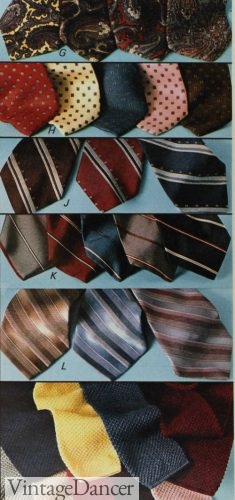Neckties, bowties, scarves, and cravats — men’s neckwear is one of the most fascinating elements of vintage men’s apparel. With just the change of a tie, a man can alter his persona from ’20s gangster to ’50s rebel to ’60s ad men. At first glance through 20th century men’s tie history, you may think a tie is a tie is a tie, but with a keen eye on the subtle differences between colors, patterns, materials, and size, you will be a vintage necktie expert in no time.
1920s Men’s Ties
During the teens and most of the ’20s, men’s neckwear came in such a variety of colors, shapes and styles, that I would call it the best era of men’s ties. It was also the start of the modern necktie as we know it today.
Previously, the bow tie was very popular for day wear with patterns of horizontal stripes, plaids and polka dots in light pinks, purples, greys, and greens. Neckties, too, were full of color from the “club” or “regimental” striped ties started in Europe to the gold toned paisley prints that were especially popular in the USA. All-over prints of stripes, checks, and diamond patterns also reigned in Europe.
- 1920s bow tie
- 1921 striped skinny tie
Neckties were thin — about 2 and 3/8 inches — and made of very fine silk. The quality of the man was often judged by the quality of his silk tie.
One forgotten tie of the ’20s was the knit wool necktie. Made of one long 2 inch thin strip with a fringed or straight bottom edge, it is a tie that has resurfaced again and again in history. I recently saw them in my local department stores, so clearly they are back in fashion once again.
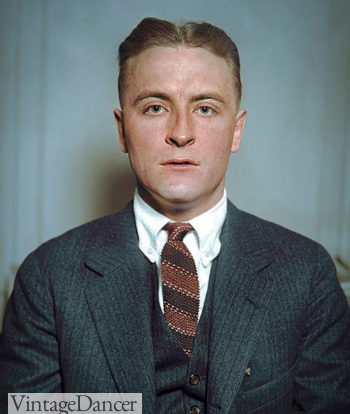
F Scott Fitzgerald wearing a stripe knit tie
The scarf tie is also somewhat back in style, too. Worn as a simple wrap and tied knot today, in the 1920s it was made of a large silk or rayon scarf that was tied in a Windsor knot and then tucked under a pullover vest or sweater (also in style this year). Shop 1920s style men’s neckties here.
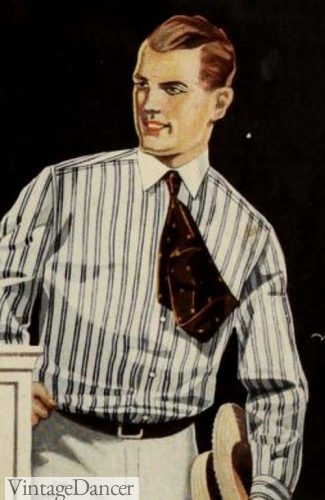
Learn even more about the history of 1920s men’s ties.
1930s Men’s Ties
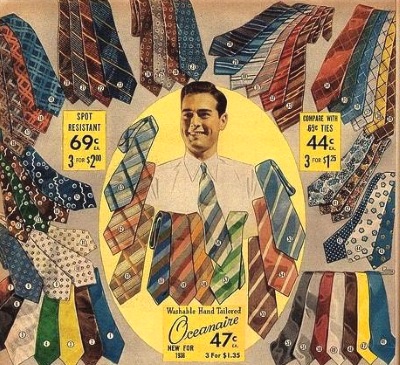
1930s Men’s ties- Plaid, Stripes, small paisley, solid silk, windowpane and large checks.
By the 1930s, scarf ties and bow ties were out of style, leaving only the silk necktie to dominate. Multiple colors of horizontal stripes, plaids, checks, windowpane, small paisley, large dots, pin dots and Art Deco motifs clashed with men’s shirts. It was a wild and colorful time in menswear.
- 1933 mens ties and scarf ties
- 1938 ties in rayon or pure silk
- 1938 men’s reversible ties
Earthy greens, yellows, peach tones, and blues were the predominant colors of the ’30s in the early years, with bold blues, reds, grey, and black popping up in the later years.
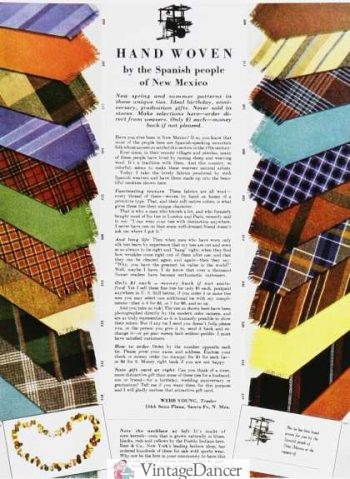
Handwoven ties
Hand-painted Art Deco designs started in the ’20s, but really found a place in the 1930s. Famous artists would hand paint ties as a way of bringing art into everyday life. Necktie widths grew wider (about 3.5 inches) and shorter to go with the wider suit lapels and oversized shirt collars of the ’30s. Shop 1930s style men’s ties.
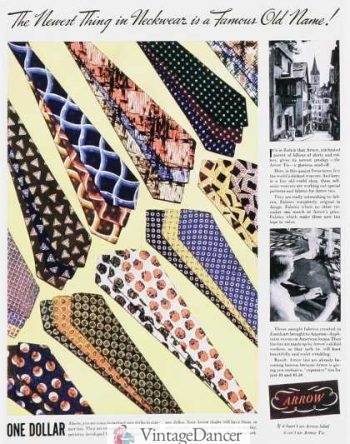
1930s vivid Art Deco ties
1940s Men’s Ties
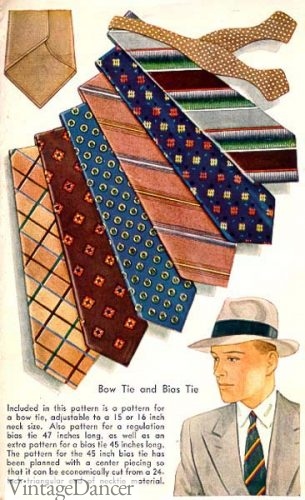
1941 men’s conservative drab colored ties
When war time struck, so did restrictions on men’s ties. Silk was in short supply, so rayon and wool knit ties were the thing to buy — or better yet, make (thanks, Mom!). Shortly after WWII, men’s ties took a radical shift in style. No longer confined by fabric rationing, men’s ties got wide — very wide — and short to the point of ending above the belt line, which was already high on the waist.
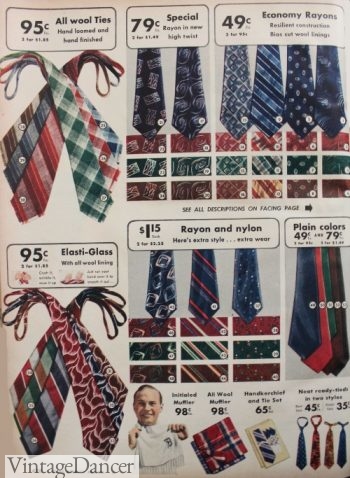
1942 Men’s plaid, stripe and tone on tone abstract print neckties
In the early ’40s, neckties were tied in a Windsor knot. This fat knot fit well into the wide spread collars on dress shirts and wide lapels of 1930s business suits. Necktie colors reflected the serious nature of the world. Solid or striped ties of maroon-red, blue, white, and black were about the only choices. Most prints were color on a white background.
As the War waged on, matte finished rayon striped regimental ties on blue, silver, and red replaced Japanese silk ties. Wool and wool-cotton ties were also used instead of silk. They could be made smooth like rayon but didn’t wrinkle. They also took large patterns well such as stripes, checks and plaid.
One brief trend around 1942 was the center striped tie consisting of one long vertical stripe down the center of the tie. The color could be solid or textured such as herringbone, check, or tweed-like weaves.
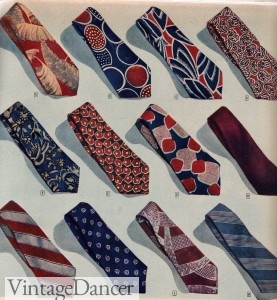
1944 Patriotic Red and Blue Colored Tie Patterns
By 1943, men were tired of drab conservatism. They turned to new, bold colors and big geometric designs. Set against bland grey and blue suits they brought joy to the wearer and those around him. Maroon, green, brown, blue, and gold were saturated colors. Patriotic red, blue and white in abstract patterns were also very popular. Tie lengths fluctuated between 45 and 47 inches long coordinating with the rise and fall of men’s trousers. By 1950, tie lengths reached 50 inches.
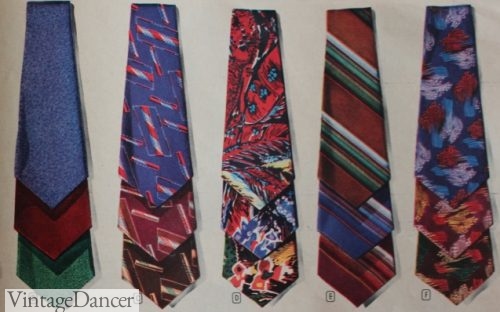
1947 “painted” men’s neckties, stripes and textured solids
The need for self expression increased during the war and after. Hand-painted ties sold for about $25 and were one way men could express themselves via their hobbies and interests, including the new fascination with “modern art.” Men amassed huge collections of neckties, and tie-swaps and tie-swapping clubs grew to be popular gatherings.
Geometric, curly lines, monograms, and Art Deco style patterns were painted in bright colors of blue, red, gold and brown. Animals, plants, flowers, birds, western, and tropical printed themes were everywhere. Handpainted ties were often themed around the wearer’s hobbies and interests, like painting, fishing, sailing or hunting. Handpainted ties needed a large canvas, so naturally neckties grew to be 4.5 to 5 inches wide. They were given nicknames “scrambled egg ties” for the mix of muddled circles and darts the patterns created, or Belly Warmers.
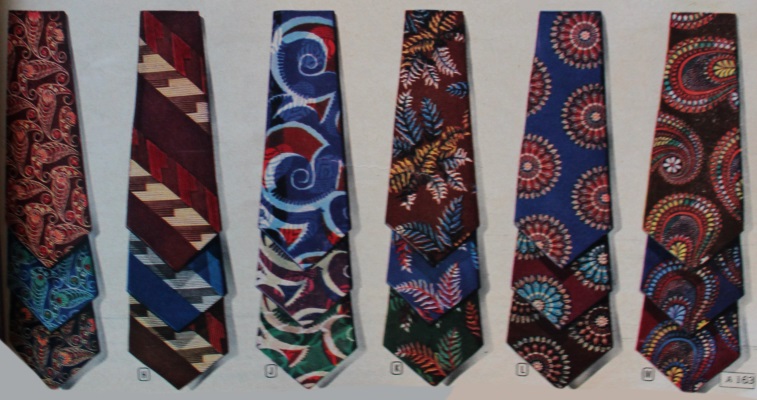
1947 more painted ties in bold abstract “modern art” designs
The very wide “Belly Warmer” tie, with a hula girl and palm trees painted on it, was especially popular in America. Introduced as a joke, the belly warmer ties became trendy after actors like Bob Hope, Alan Ladd and Danny Kay were seen wearing them. Soon after, scantily clad pin-up girls painted on the back side of a tie became a fashionable secret.
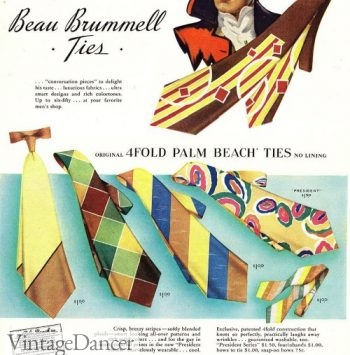
1948 Bold Look geometric ties
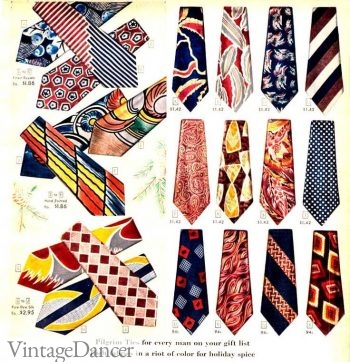
1949 bold prints, geometric designs
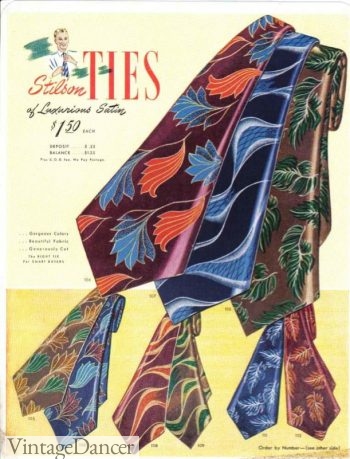
Late 1940s men’s nature themed ties
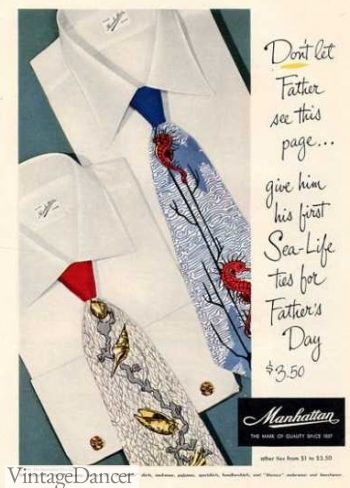
1940s men’s “sea life” neckties
In 1948, the Bold Look became the inspiration for all men’s clothing. Wide fit clothes (similar to the 1930s) with wide collars, wide knot ties and “bold” new colors and big geometric patterns replaced smaller designs and military colors (red, navy blue, khaki). Hand-painted ties continued to be trendy and became even more so in the 1950s, when novelty designs were on trend.
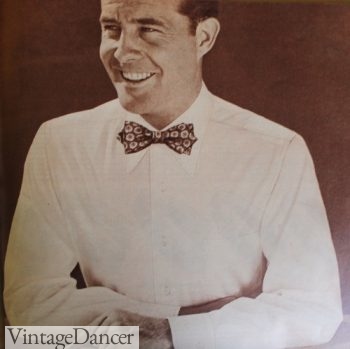
1944 Men’s foulard prints bow tie with tipped ends
The bow tie was an alternative to the necktie in the 1940s. It had lost favor, possibly because it wasn’t bold enough compared to handpainted ties. They, too, were made of rayon in medium sized prints with an adjustable neckband up to 16 inches. The ends could be square (butterfly) or diamond tipped. Maroon, blue or brown dominated colors choices through the mid ’40s. In the late ’40s, bow ties vanished again except as part of work uniforms in plain, wool or cotton types.
Learn how to tie a classic bow tie.
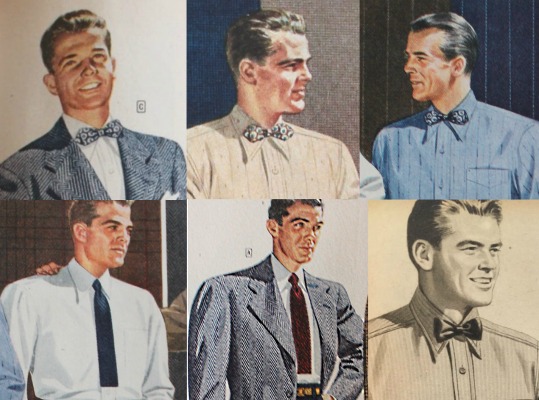
1940s men’s bow ties and knit neckties
The final style of necktie men wore was the knit tie. They were usually handmade items of plain color knitted or crochet rows. They were very economical and easy to make, washed well and were thinner (about 3 inches) with a square edge. I could only find a few examples of these ties, worn by younger men around the mid 1940s. It had been a classic style for decades so it’s likely they never went “out of style”, but they were worn mostly with casual clothing or work uniforms.
See more pictures of men’s 1940s neckties via McCall’s sewing patterns. Also, the 1940s men’s dress shirts section here has many examples of ties and how they were paired with dress shirts.
Shop 1940s style men’s ties in classic vintage patterns. Look on eBay.com or Etsy.com for vintage 1940s ties.
1950s Men’s Ties
The painted tie continued to be popular in the early ’50s. The designs became more abstract, cubist, modern, and artistic than the ’40s designs. It was less about the hobby and more about a play on color, shape and stand-out designs. They are highly collectible now.
- 1951 neckties
- 1950s Art print ties
- Early 1950s, men’s Cutter ties in art prins
- Geo Print Men’s Ties
Wide ties gradually narrowed again by the mid ’50s to a “normal” width of about 3 and 1/8 inches. Bow ties, too, slimmed down and straightened out into the skinny ribbon tie. The conservative look was in with businessmen in grey flannel suits, Oxford shirts, and a graduated striped tie. Neutral ties with light patterns were also common. Young kids were wearing knit ties on college campuses, a trend last seen in the ’20s.

1954 men’s bow ties
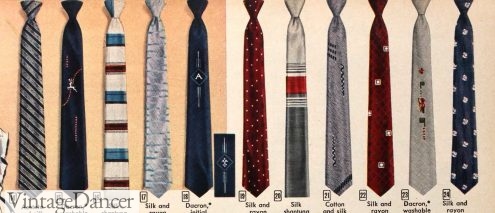
1957 skinny ties
It wasn’t the pattern or color that was big news in the early ’50s, but the material. Among traditional silk and wool, men could now find the latest synthetic Dracon knit, which offered a noticeable texture on solid colors. Other textured materials like coarse silk and shantung were trending in the mid ’50s in America. England saw silky fleece and angora mohair as a practical, no crush, the material in during winter.
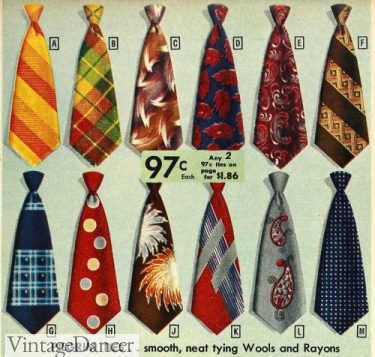
1955 wool and rayon men’s ties
In 1956, all-cotton ties, advertised as washable, made life easier on housewives. Bow ties experienced a resurgence in 1957. They were formal, yet fun, coming in textured fabrics as well as small “modern” prints. These designs were inspired by the atomic age yet had an Art Deco look to them. Square ends ties, two tone, and butterfly bow ties were also fashionable.
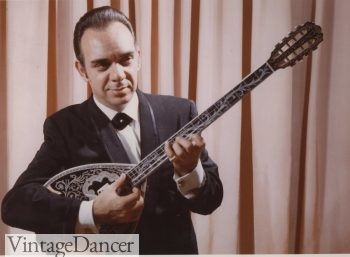
V shaped Continental tie
There was one short lived trend for Continental ties in the very late ’50s to mid ’60s. It was neither a necktie or bowtie but a wide ribbon of black satin or silk that crossed over at neck and held together by a pearl snap or pin. It was designed for formalwear, but I have seen several 1950s photographs of men wearing them with business suits as well. Today, they are popular with Western fashion and sometimes called crossover ties or Western bow tie. The V-shaped version is usually called a Bulldogger tie. Both crossover and V shaped continental ties were seen in the Victorian era among Western outlaws — or at least that’s how the movies featured them.
- 1951 men’s ties
- 1952 men’s ties
- 1954 mens ties
- 1954 men’s ties and bowties
- 1957 brown skinny ties
- Late 1950s geo ties
1960s Men’s Ties
Ties kept on narrowing into the 1960s when the ultra thin 2 inch skinny tie came in vogue to go with skinny suits. Solid colors and striped designs were preferred in most ’50s business attire, while mod art designs reigned in the ’60s. Both traditionally pointed neckties and square end ties had their place. Pink, purple, yellow, and aqua colors were seen with large geometric shapes, wide stripes, and square dots.
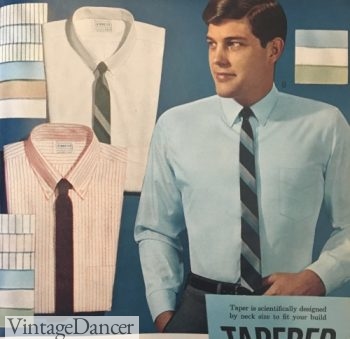
1964 basic skinny ties in solid and stripes
In 1964 the silk ascot returned in solid colors, figure prints, and mod patterns. They were worn tucked into unbuttoned shirts. The puffed ascot look was very chic and quite big for the time. That is until 1968, when the wide tie returned bigger than ever.
- 1966 mens skinny ties
- 1968 Men’s Skinny Ties over Colorful Dress Shirts
Most ties were 3 and 3/4 inch but they could go up to 5 inches with big knots that needed a wide-cut collar such as the spread to accommodate them. This enormously wide tie was called the Kipper tie, created by Michael Fish. The kipper tie was huge and came in bold colors, small feminine prints, and psychedelic swirls. It was meant to stand out and give the wearer true personality. The Kipper tie was literally the biggest thing to happen to men’s neckwear in decades.
Shop 1950s or 1960s men’s ties.
In formal wear, the big necktie inspired the full butterfly (club bow) or semi butterfly bow tie both in traditional black, midnight blue and the new white pique. These bow ties usually had square ends, which were a neater appearance against the simple tuxedo. These were contrasted with the very skinny ribbon bow tie and thistle tie. There was also the velvet tie trend in Britain. The 60s couldn’t make up their mind on just one look. The youth, however, could agree that the only time to wear a tie was for prom and weddings and on those occasions, it must be a bow tie.
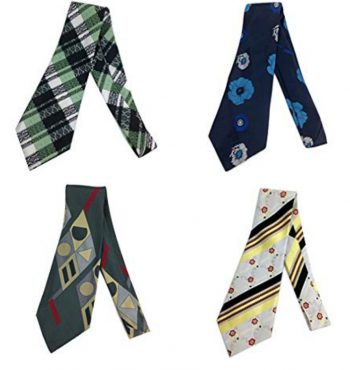
Kipper ties sold by Anthony’s Importers on Amazon
In formal wear, the big necktie inspired the full butterfly (club bow) or semi butterfly bow tie both in traditional black, midnight blue and the new white pique. These bow ties usually had square ends, which were a neater appearance against the simple tuxedo. These were contrasted with the very skinny ribbon bow tie and thistle tie. There was also the velvet tie trend in Britain. The 60s couldn’t make up their mind on just one look. The youth, however, could agree that the only time to wear a tie was for prom and weddings and on those occasions, it must be a bow tie.
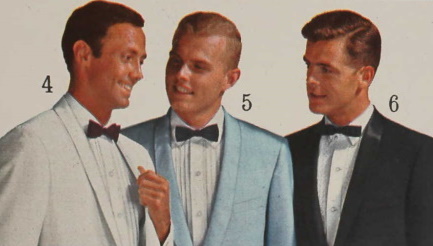
1965 men’s bow ties
1970s-1980s Men’s Ties
One popular new 1970s tie was the neckerchief. A square silk scarf was tied around the neck and held in place with either a square knot or a tie ring with ends pointing to the sides. The hippies wore their neck scarves loose without a pin so as not to be confused with an actual necktie.
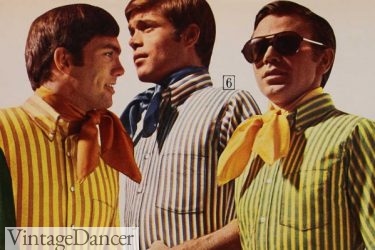
1970 scarf ties
If you like crazy patterns, then ties of the ’70s are for you. Earth tones and plant life, large paisley and animal prints made of wool and polyester materials gave the ties a new texture. Once again ties expanded to about 4.5 inches wide, but longer this time (some of those men’s pants were low riders). The inspiration was taken from ’40s American ties, but this time the patterns were rainbows, swirls, and clouds in pastel hues.
- 1973 check and abstract pattern ties
- 1973 pattern and color block ties
- 1973 chevron tie or plaid ties
- 1975 floral tie tie
- 1975 classic repp stripe wide ties
- 1975 herringbone ties
- 1975 painted te and stripe/dots
- 1976 paisley ties
The 1970s bow tie also experience a revival in the biggest, exaggerated cut yet.
- 1974 polka dot butterfly bow ties
- 1974 mens ties and bow ties
The rise of the no-tie was the trend for the ’70s and would have continued had the conservative ’80s not brought the rebellious youth back to society and into business suits, and power suits, once again.
The 1980s is where I draw the line at my vintage research. Born in the ’80s, it is always hard to think of your youth as “vintage” now. I do, however, remember buying my dad a tie every year for Christmas. He liked wide horizontal striped ties in navy blues, reds and greys the most. Occasionally, we would get him a funny Christmas tie with cartoon characters all over it. I am pretty sure that has been a tradition among families for most of the century.
- 1985 mens silk ties
- 1987 mens silk ties and knit ties
Do you want to buy, sell or get help dating your vintage tie? Join the I love Vintage Ties Facebook group.
Debbie Sessions has been teaching fashion history and helping people dress for vintage themed events since 2009. She has turned a hobby into VintageDancer.com with hundreds of well researched articles and hand picked links to vintage inspired clothing online. She aims to make dressing accurately (or not) an affordable option for all. Oh, and she dances too.
